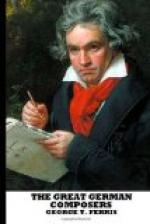The “Sinfonia Eroica,” the “Choral” only excepted, is the longest of the immortal nine, and is one of the greatest examples of musical portraiture extant. All the great composers from Handel to Wagner have attempted what is called descriptive music with more or less success, but never have musical genius and skill achieved a result so admirable in its relation to its purpose and by such strictly legitimate means as in this work.
“The ‘Eroica,’” says a great writer, “is an attempt to draw a musical portrait of an historical character—a great statesman, a great general, a noble individual; to represent in music—Beethoven’s own language—what M. Thiers has given in words and Paul Delaroche in painting.” Of Beethoven’s success another writer has said: “It wants no title to tell its meaning, for throughout the symphony the hero is visibly portrayed.”
It is anything but difficult to realize why Beethoven should have admired the first Napoleon. Both the soldier and musician were made of that sturdy stuff which would and did defy the world; and it is not strange that Beethoven should have desired in some way—and he knew of no better course than through his art—to honor one so characteristically akin to himself, and who at that time was the most prominent man in Europe. Beethoven began the work in 1802, and in 1804 it was completed, and bore the following title:
Sinfonia grande
“Napoleon Bonaparte”
1804 in August
del Sigr
Louis van Beethoven
Sinfonia 3.
Op. 55.
This was copied and the original score dispatched to the embassador for presentation, while Beethoven retained the copy. Before the composition was laid before Napoleon, however, the great general had accepted the title of Emperor. No sooner did Beethoven hear of this from his pupil Ries than he started up in a rage, and exclaimed: “After all, then, he’s nothing but an ordinary mortal! He will trample the rights of men under his feet!” saying which, he rushed to his table, seized the copy of the score, and tore the title-page completely off. From this time Beethoven hated Napoleon, and never again spoke of him in connection with the symphony until he heard of his death in St. Helena, when he observed, “I have already composed music for this calamity,” evidently referring to the “Funeral March” in this symphony.
The opera of “Fidelio,” which he composed about the same time, may be considered, in the severe sense of a great and symmetrical musical work, the finest lyric drama ever written, with the possible exception of Gluck’s “Orpheus and Eurydice” and “Iphigenia in Tauris.” It is rarely performed, because its broad, massive, and noble effects are beyond the capacity of most singers, and belong to the domain of pure music, demanding but little alliance with the artistic clap-trap of startling scenery and histrionic extravagance. Yet our composer’s conscience shows its completeness in his obedience to the law of opera; for the music he has written to express the situations cannot be surpassed for beauty, pathos, and passion. Beethoven, like Mendelssohn, revolted from the idea of lyric drama as an art-inconsistency, but he wrote “Fidelio” to show his possibilities in a direction with which he had but little sympathy.




